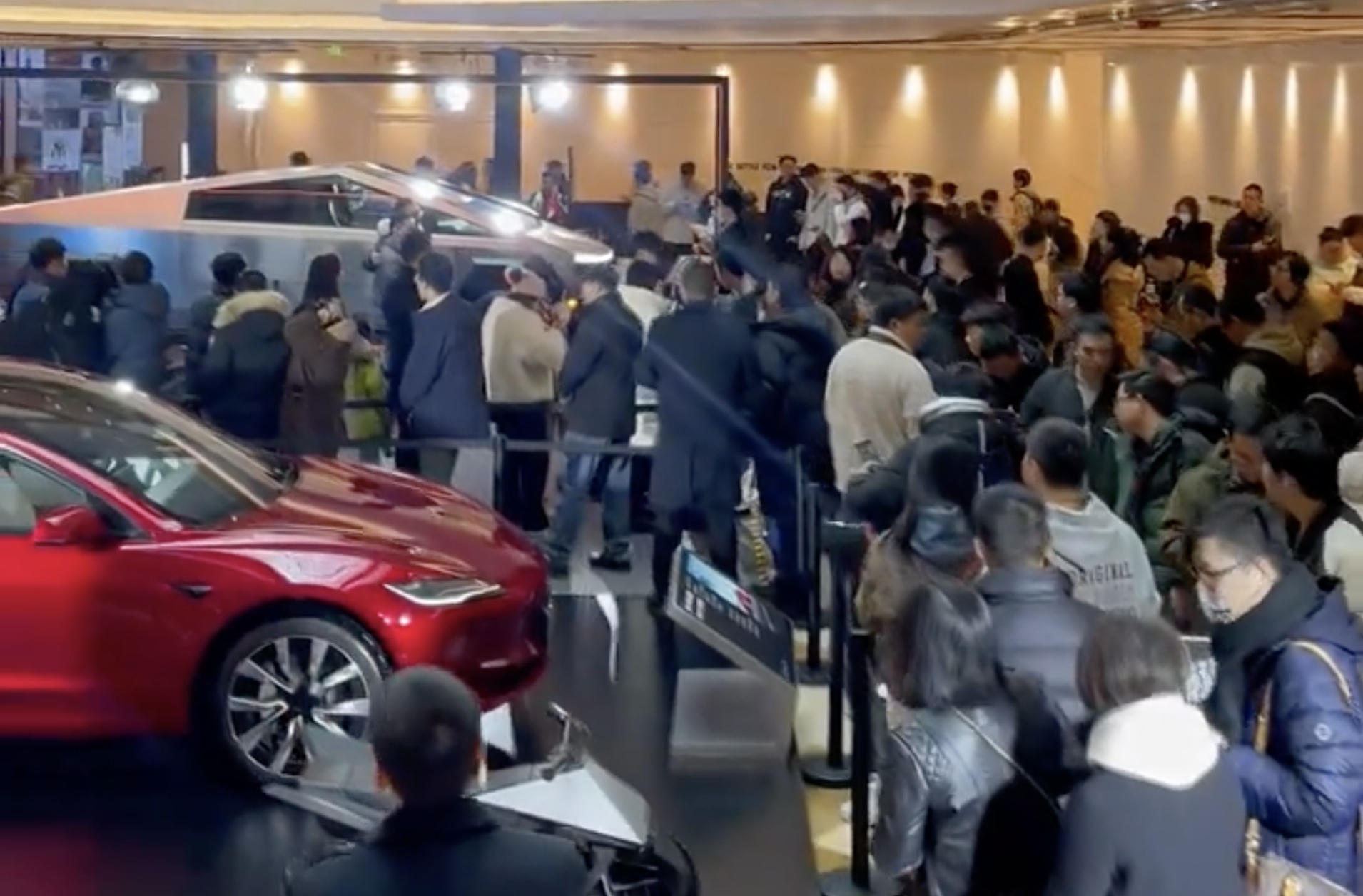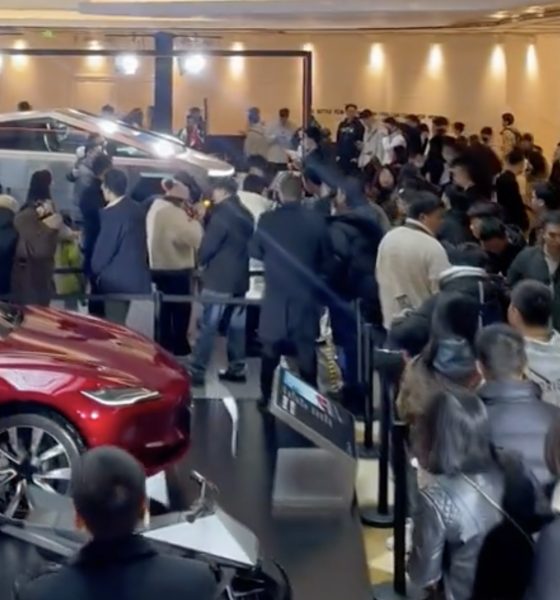China is not a country of pickup trucks. China is the world’s largest automotive market, and in 2023, sales accelerated to a record 30.09 million units, approximately 512,000 of which were pickup trucks. This means that in 2023, pickup trucks accounted for just about 1.7% of the Chinese auto market.
Part of this is due to the fact that pickup trucks are classified as light trucks in China, so they face restrictions compared to passenger cars like the Model Y. Pickup trucks are required to drive on the rightmost “slow” lane on highways, and they are only allowed to travel up to 100 kph (62 mph). They are subjected to mandated scrapping after 15 years as well, and some Chinese cities impose limitations on pickups entering urban areas.
Join the crowd and feel the enthusiasm! ??? https://t.co/nnLQGjfill— Tesla Asia (@Tesla_Asia) January 29, 2024
One could then not be faulted for stating that the Tesla Cybertruck looks like a pretty bad fit for China. Pickup trucks are not popular at all in the country, and the Cybertruck is very expensive to begin with. With this in mind, it does seem that bringing the Cybertruck to China, where it is not even sold today, was an exercise in futility. But as per videos taken of the vehicle amidst the Cybertruck’s multi-city tour, it appears that bringing the all-electric pickup truck to China may very well have been worth it.
China is going crazy for the Cybertruck, Tesla absolutely needs to find a way to get through all regulations to sell it here, let alone even build it right there in the heart of Giga Shanghai bc it’s clear, they really want it @elonmusk pic.twitter.com/hyaoQEqnj9— Teslaconomics (@Teslaconomics) January 28, 2024
Videos posted on social media revealed that the Cybertruck has attracted large crowds of people. In Shanghai, long lines of people could be seen waiting for their chance to see the Cybertruck in person. The same is true for the Nanjing Xinjiekou Deji Plaza, where numerous people could be seen visiting the Cybertruck. Overall, the Cybertruck tour in China seems to be very successful, and the all-electric pickup truck has become an instant celebrity.
Cybertruck China Tour was really eventful on day 1 in all 8 locations across China. People are genuinely interested in this unique vehicle. There’s a market there for this type of recreational/adventure vehicle. Hopefully Tesla will be able to tweak it to comply with pedestrian… pic.twitter.com/xd7gCAE0gn— Ray (@ray4tesla) January 28, 2024
The reasons for this insane reaction could be a variety of things, though Tesla bulls such as Wall Street veteran and The Future Fund Managing Partner Gary Black have noted in the past that a vehicle like the Cybertruck will have a “halo effect” of sorts. The vehicle’s current reception in China, where the Cybertruck may not even be sold at all, suggests that this halo effect is very much present.
? Wow, how many people are excited about this new @Cybertruck toy in China? https://t.co/LjNqV36BbZ pic.twitter.com/tlnIqZUjQ7— Woodland?⚡️??☀️ (@Woodland_00) January 28, 2024
It remains to be seen if the Cybertruck would be a success or not. It continually attracts equal amounts of love and hate from consumers, especially in the United States, which would likely be its primary market. One thing’s for sure, however. The public’s reaction and apparent support for the vehicle in China would be nowhere close if the Cybertruck were a conventional pickup truck that just happens to be electric.
8 Cybertruck display locations in China seen on Day 1. pic.twitter.com/PYE1eS98PX— Ray (@ray4tesla) January 28, 2024
Don’t hesitate to contact us with news tips. Just send a message to simon@teslarati.com to give us a heads up.

Elon Musk
Elon Musk and Tesla AI Director share insights after empty driver seat Robotaxi rides
The executives’ unoccupied tests hint at the rapid progress of Tesla’s unsupervised Robotaxi efforts.

Tesla CEO Elon Musk and AI Director Ashok Elluswamy celebrated Christmas Eve by sharing personal experiences with Robotaxi vehicles that had no safety monitor or occupant in the driver’s seat. Musk described the system’s “perfect driving” around Austin, while Elluswamy posted video from the back seat, calling it “an amazing experience.”
The executives’ unoccupied tests hint at the rapid progress of Tesla’s unsupervised Robotaxi efforts.
Elon and Ashok’s firsthand Robotaxi insights
Prior to Musk and the Tesla AI Director’s posts, sightings of unmanned Teslas navigating public roads were widely shared on social media. One such vehicle was spotted in Austin, Texas, which Elon Musk acknowleged by stating that “Testing is underway with no occupants in the car.”
Based on his Christmas Eve post, Musk seemed to have tested an unmanned Tesla himself. “A Tesla with no safety monitor in the car and me sitting in the passenger seat took me all around Austin on Sunday with perfect driving,” Musk wrote in his post.
Elluswamy responded with a 2-minute video showing himself in the rear of an unmanned Tesla. The video featured the vehicle’s empty front seats, as well as its smooth handling through real-world traffic. He captioned his video with the words, “It’s an amazing experience!”
Towards Unsupervised operations
During an xAI Hackathon earlier this month, Elon Musk mentioned that Tesla owed be removing Safety Monitors from its Robotaxis in Austin in just three weeks. “Unsupervised is pretty much solved at this point. So there will be Tesla Robotaxis operating in Austin with no one in them. Not even anyone in the passenger seat in about three weeks,” he said. Musk echoed similar estimates at the 2025 Annual Shareholder Meeting and the Q3 2025 earnings call.
Considering the insights that were posted Musk and Elluswamy, it does appear that Tesla is working hard towards operating its Robotaxis with no safety monitors. This is quite impressive considering that the service was launched just earlier this year.
Elon Musk
Starlink passes 9 million active customers just weeks after hitting 8 million
The milestone highlights the accelerating growth of Starlink, which has now been adding over 20,000 new users per day.

SpaceX’s Starlink satellite internet service has continued its rapid global expansion, surpassing 9 million active customers just weeks after crossing the 8 million mark.
The milestone highlights the accelerating growth of Starlink, which has now been adding over 20,000 new users per day.
9 million customers
In a post on X, SpaceX stated that Starlink now serves over 9 million active users across 155 countries, territories, and markets. The company reached 8 million customers in early November, meaning it added roughly 1 million subscribers in under seven weeks, or about 21,275 new users on average per day.
“Starlink is connecting more than 9M active customers with high-speed internet across 155 countries, territories, and many other markets,” Starlink wrote in a post on its official X account. SpaceX President Gwynne Shotwell also celebrated the milestone on X. “A huge thank you to all of our customers and congrats to the Starlink team for such an incredible product,” she wrote.
That growth rate reflects both rising demand for broadband in underserved regions and Starlink’s expanding satellite constellation, which now includes more than 9,000 low-Earth-orbit satellites designed to deliver high-speed, low-latency internet worldwide.
Starlink’s momentum
Starlink’s momentum has been building up. SpaceX reported 4.6 million Starlink customers in December 2024, followed by 7 million by August 2025, and 8 million customers in November. Independent data also suggests Starlink usage is rising sharply, with Cloudflare reporting that global web traffic from Starlink users more than doubled in 2025, as noted in an Insider report.
Starlink’s momentum is increasingly tied to SpaceX’s broader financial outlook. Elon Musk has said the satellite network is “by far” the company’s largest revenue driver, and reports suggest SpaceX may be positioning itself for an initial public offering as soon as next year, with valuations estimated as high as $1.5 trillion. Musk has also suggested in the past that Starlink could have its own IPO in the future.
News
NVIDIA Director of Robotics: Tesla FSD v14 is the first AI to pass the “Physical Turing Test”
After testing FSD v14, Fan stated that his experience with FSD felt magical at first, but it soon started to feel like a routine.

NVIDIA Director of Robotics Jim Fan has praised Tesla’s Full Self-Driving (Supervised) v14 as the first AI to pass what he described as a “Physical Turing Test.”
After testing FSD v14, Fan stated that his experience with FSD felt magical at first, but it soon started to feel like a routine. And just like smartphones today, removing it now would “actively hurt.”
Jim Fan’s hands-on FSD v14 impressions
Fan, a leading researcher in embodied AI who is currently solving Physical AI at NVIDIA and spearheading the company’s Project GR00T initiative, noted that he actually was late to the Tesla game. He was, however, one of the first to try out FSD v14.
“I was very late to own a Tesla but among the earliest to try out FSD v14. It’s perhaps the first time I experience an AI that passes the Physical Turing Test: after a long day at work, you press a button, lay back, and couldn’t tell if a neural net or a human drove you home,” Fan wrote in a post on X.
Fan added: “Despite knowing exactly how robot learning works, I still find it magical watching the steering wheel turn by itself. First it feels surreal, next it becomes routine. Then, like the smartphone, taking it away actively hurts. This is how humanity gets rewired and glued to god-like technologies.”
The Physical Turing Test
The original Turing Test was conceived by Alan Turing in 1950, and it was aimed at determining if a machine could exhibit behavior that is equivalent to or indistinguishable from a human. By focusing on text-based conversations, the original Turing Test set a high bar for natural language processing and machine learning.
This test has been passed by today’s large language models. However, the capability to converse in a humanlike manner is a completely different challenge from performing real-world problem-solving or physical interactions. Thus, Fan introduced the Physical Turing Test, which challenges AI systems to demonstrate intelligence through physical actions.
Based on Fan’s comments, Tesla has demonstrated these intelligent physical actions with FSD v14. Elon Musk agreed with the NVIDIA executive, stating in a post on X that with FSD v14, “you can sense the sentience maturing.” Musk also praised Tesla AI, calling it the best “real-world AI” today.










